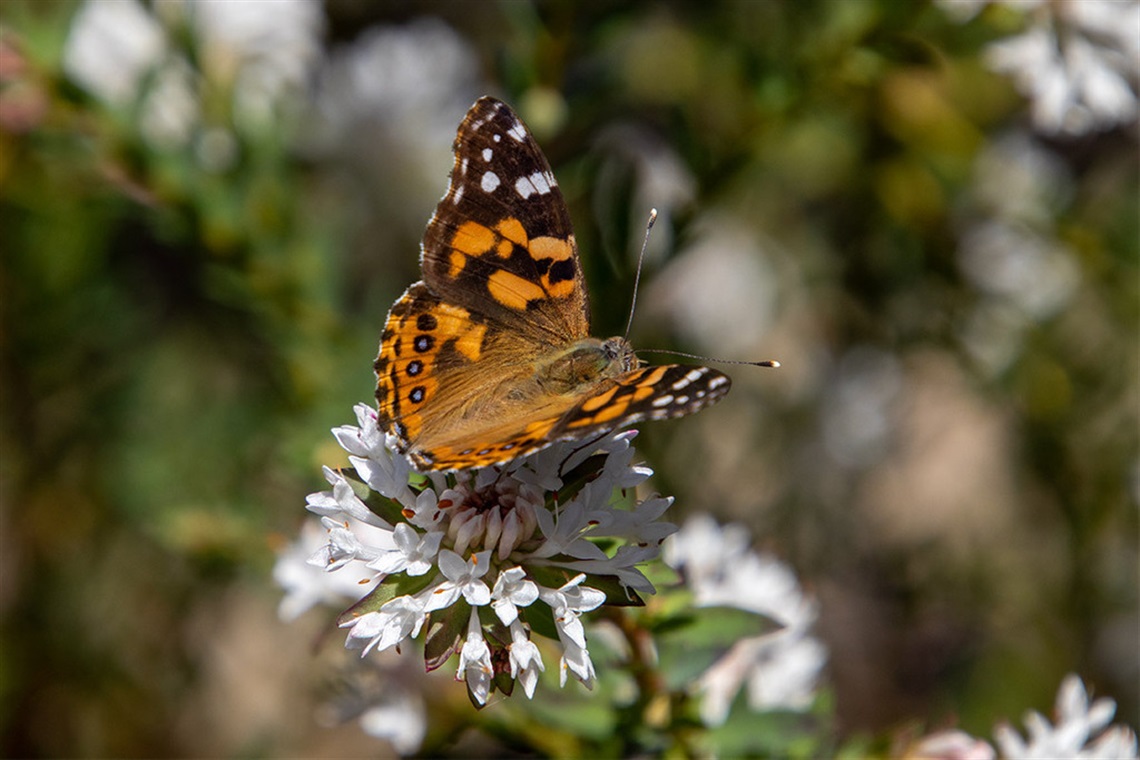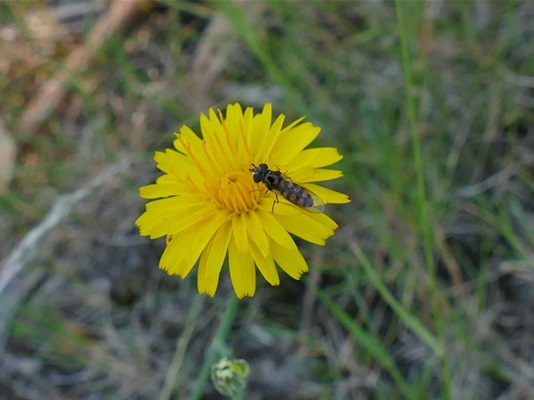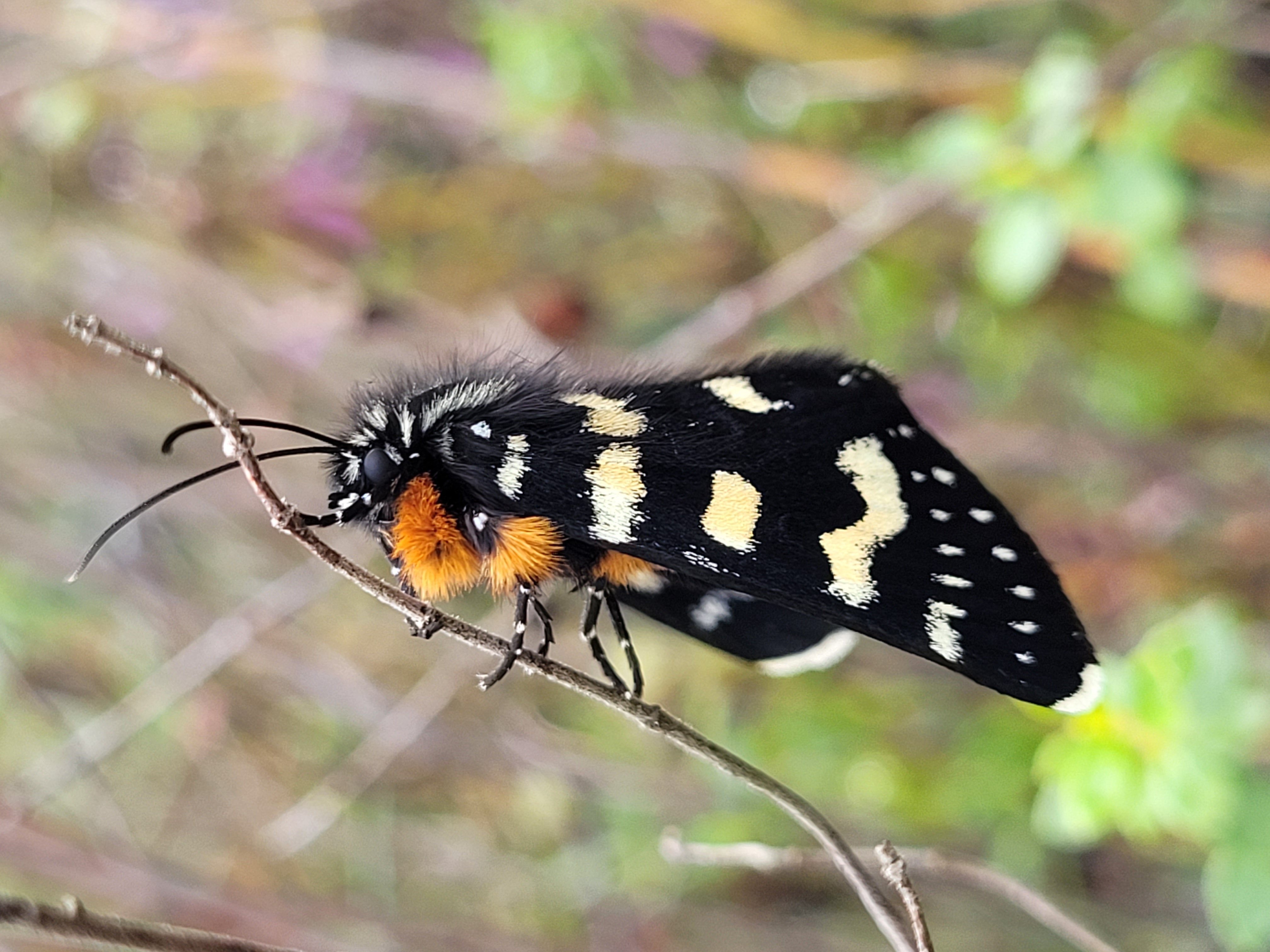Native Pollinators: Guardians of Biodiversity
Published on 23 November 2023

Image: Australian Painted Lady (Vanessa kershawi) butterfly by Suzanne B
Pollination - what is it and who does it?
Ever wondered why our wildflowers and the flowers in your garden bloom so beautifully? Well, it's all thanks to our buzzing buddies – pollinators! These tiny superheroes spread the love (and pollen) to help our plants.
Pollination is nature's matchmaking. Bees, butterflies, and other insects help flowers reproduce by transferring pollen from one plant to the female reproductive parts of flowers on another. This leads to fertilisation which helps plants develop seeds and fruit.
Australia is home to thousands of species of pollinators including native bees, flies, wasps, beetles, moths, butterflies, skippers, ants, birds, bats, and small mammals. Native bees are particularly effective pollinators because they need pollen to feed their young, visiting numerous flowers and transferring pollen in the process.
Why are insect pollinators so important?
With around 65% of Australia’s flowering plants relying on insect pollinators for reproduction, these tiny creatures play a vital role in the survival of our wildflowers (and food crops!), contributing significantly to the preservation of biodiversity and ecological stability. A hefty task for such a petite contributor!
Not only that, but having certain native pollinators such as predatory wasps and beetles in your garden will help control pest populations.
The intricacies of pollinator-plant connections
Native insects have evolved specialised ways to pollinate specific wildflowers:
- Long-tongued bees like the Leafcutter Bee pollinate deep tubular flowers such as those on Common Correa and Common Heath.
- Some native bees such as the Blue banded bee perform buzz pollination, vibrating flowers to release pollen, which is crucial for the seed production of Flax Lilies, Guinea Flower, Kangaroo Apple and Fringe Lilies.
- Bush peas have evolved to rely on tiny but strong insects to trigger the flower to open and expose its pollen.
- Some orchids, like the Tiger Orchid, mimic nearby bush pea flowers to ensure pollen transfers.
- Certain insects have adapted to synchronise their life cycles with specific flowering periods, ensuring they are active when the wildflowers are ready for pollination.
- Some pollinators like moths take on the night shift to align with the specific flowering times of nocturnal wildflowers.
Why do they need our help?

The world is currently facing a significant decline in pollinator populations, and Australian native pollinators are suffering the same fate. Our pollinators are facing numerous threats, such as pesticide use, habitat loss and competition by more aggressive non-native pollinators.
Chemicals such as pesticides and even some organic weed control products can harm pollinator populations.
In addition to the loss of bushland and open space as a result of urbanisation, the removal of fallen twigs and stems in gardens that favour aesthetics over function, can also eliminate potential pollinator nest sites.
The introduction of European honeybees has put native bee populations at further risk, especially when colonies vie for the same nectar and pollen resources in urban gardens and bushland.
Image: Common Halfband (Melangyna viridiceps) by John Cull
How can you support pollinators and attract them to your garden?
Observe and start identifying your local pollinators using these handy guides:
Other helpful hints:
- Continue learning and share your knowledge.
- Reduce chemical use wherever possible.
- Provide habitat - diversity is key!
- Create a pollinator pad in your garden.
- Include a pollinator nest.
- Encourage connectivity of habitat - create a habitat stepping stone in your garden.
- Keep ‘tidying-up’ of your garden to a minimum, and avoid over-clearing certain weeds that are being used by pollinators.
- Include plants suitable for native Australian pollinators. Make sure you provide a variety of plants to ensure flowers of all different colours, shapes, sizes and heights are available throughout the year. Plant large swathes of flowers instead of single plants spaced within the garden.
- Plants indigenous to Maroondah that support & attract pollinators and their larvae include:
- Acacia spp. - Wattles
- Carex spp. - Sedges
- Chrysocephalum semipapposum - Clustered Everlasting
- Correa reflexa - Common Correa
- Gahnia spp. - Saw-sedges
- Glycine clandestine - Twining Glycine
- Goodenia spp.
- Hakea spp.
- Hardenbergia violacea - Purple Coral-pea
- Indigofera australis - Austral Indigo
- Kennedia prostrata - Running Postman
- Leptospermum continentale - Prickly Tea-tree
- Lomandra spp. - Mat-rush
- Poa spp. - Tussock-grasses
- Prostanthera lasianthos - Victorian Christmas Bush
- Rytidosperma spp. - Wallaby Grasses
- Themeda triandra - Kangaroo Grass
By encouraging and supporting the diversity of native pollinators, you’ll not only be helping to create a healthy ecosystem and protect these species for future generations, you’ll also be helping to create a natural space filled with beautiful creatures that are an absolute joy to watch!

Image: Willow-herb Day-Moth (Phalaenoides tristifica) by Daniel Flaim